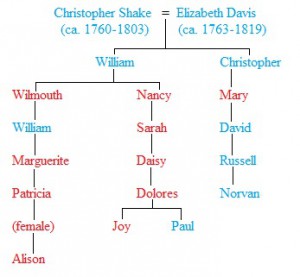 Over the last year or so I have had some interesting matches amongst “DNA Relatives” on the website 23andme.com. I manage the profiles of my parents, my mother’s brother, and my wife’s parents. So far, the most interesting results have all come about from my mother and uncle. While all the profiles have given me several DNA relatives predicted to be anywhere from third to fifth cousins, only my mother and uncle’s matches have been linked me with cousins with whom we have been able to determine the exact degree of the relationship.
Over the last year or so I have had some interesting matches amongst “DNA Relatives” on the website 23andme.com. I manage the profiles of my parents, my mother’s brother, and my wife’s parents. So far, the most interesting results have all come about from my mother and uncle. While all the profiles have given me several DNA relatives predicted to be anywhere from third to fifth cousins, only my mother and uncle’s matches have been linked me with cousins with whom we have been able to determine the exact degree of the relationship.
A common question raised when I speak on DNA involves how long we carry the DNA of a given ancestor. While our Y-DNA and mtDNA have specific gender-linked patterns of inheritance, our autosomal DNA is more complex. Many of our DNA relatives are predicted to be our relatives within five to seven generations, but if you have identified a relative within that time frame, and you show no DNA in common, are you not related? Has the DNA linking the two of you faded away?
A recent example in my own family involved identifying two relatives, both of them descended from the Shake family of Jefferson County, Kentucky. Alison is a great-great-great-great-granddaughter of William and Sarah (Smith) Shake, my mother and uncle’s great-great-great-grandparents, thus making Alison and my mother fourth cousins once removed. Norvan is a great-great-great-grandson of Christopher and Elizabeth (Davis) Shake, the parents of our William, thus making Norvan and my mother also fourth cousins once removed, but in the senior generation (i.e. Alison is the daughter of my mother’s fourth cousin, while Norvan is the fourth cousin of my mother’s mother). So they are descendants of the Shake family at three different generations, with Norvan splitting off at one earlier generation (see above chart, males in blue and females in red).
23andme allows you to compare your DNA bit by bit. The amount of DNA shared between us all is as follows (my mother’s name is Joy and her brother is Paul):
While my uncle shares two DNA segments with the two Shake relatives, and my mother only shares one, her segment is one of the two segments that my uncle shares. The amount of DNA they all share is predictable for relatives of this degree of kinship, and the fact that my uncle has just a little bit more “Shake DNA” than my mother is not surprising. What is interesting is when I compare Alison to Norvan, their kinship between each other is fourth cousins twice removed. They have no DNA in common:
Yet they are related through the same ancestors my mother and uncle are, for which a portion of “Shake DNA” was shared. My mother and uncle are one generation closer in kinship to both Alison and Norvan (but in different directions) than Alison and Norvan are to each other, and in this scenario, this extra generation is where their common “Shake DNA” was perhaps “shaken off!”
Share this:
About Christopher C. Child
Chris Child has worked for various departments at NEHGS since 1997 and became a full-time employee in July 2003. He has been a member of NEHGS since the age of eleven. He has written several articles in American Ancestors, The New England Historical and Genealogical Register, and The Mayflower Descendant. He is the co-editor of The Ancestry of Catherine Middleton (NEHGS, 2011), co-author of The Descendants of Judge John Lowell of Newburyport, Massachusetts (Newbury Street Press, 2011) and Ancestors and Descendants of George Rufus and Alice Nelson Pratt (Newbury Street Press, 2013), and author of The Nelson Family of Rowley, Massachusetts (Newbury Street Press, 2014). Chris holds a B.A. in history from Drew University in Madison, New Jersey.View all posts by Christopher C. Child →

